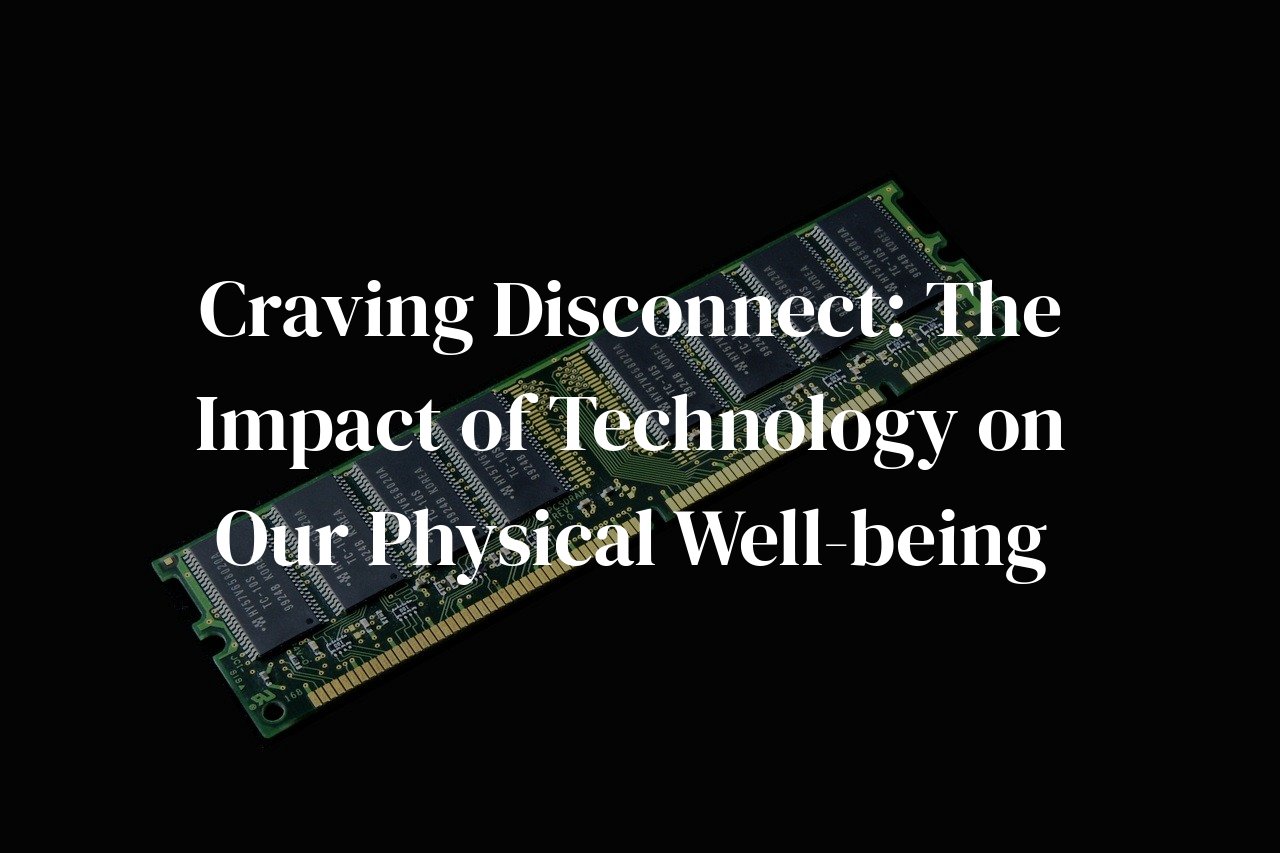
In today’s hyper-connected world, our reliance on digital devices has skyrocketed, leading many to wonder about the potential health implications. This post delves into the profound effects of technology addiction on our physical well-being and explores the benefits of a digital detox. By reading this post, you’ll gain insights into how excessive screen time can affect your body and learn practical steps to reclaim your health.
Table of Contents
Understanding Technology Addiction: Symptoms and Statistics
Understanding technology addiction is essential in today’s hyper-connected world. This addiction isn’t just about social media; it encompasses video games, online shopping, and even relentless news consumption. The term ‘technology addiction’ emerged as a counterpart to substance addiction, reflecting a dependency that can have both physical and psychological ramifications.
One primary symptom is the inability to limit screen time. Individuals often find themselves drawn to their digital devices even when they intend to take a break. This can manifest as a compulsive need to check notifications or scroll through feeds without any conscious intention.
Another key symptom is neglect of personal responsibilities. Whether it’s skipping meals, missing appointments, or not engaging with loved ones, the addictive pull of technology can sabotage our daily lives. This mirrors the behaviors seen in other forms of addiction, where the addictive substance or activity takes precedence over basic needs and responsibilities.
Physical symptoms shouldn’t be ignored either. These can range from vision problems, often referred to as ‘digital eye strain,’ to headaches and even musculoskeletal issues such as ‘text neck’ or carpal tunnel syndrome. Technology addiction is not just a mental strain; it has tangible, physical consequences.
Research statistics paint a grim picture. According to a 2020 survey by Pew Research Center, over 70% of adults acknowledge that they spend too much time on their smartphones. Moreover, a study published in the Journal of Behavioral Addictions found that 19% of people exhibited symptoms consistent with problematic internet use, impacting both their work productivity and relationships.
Teenagers are particularly vulnerable. Data from the Common Sense Media report shows that the average screen time for teens surpasses seven hours per day, excluding time spent on school work. This excessive use has been linked to issues like reduced physical activity, poor academic performance, and disrupted sleep patterns.
In my own experience, I once found myself mindlessly scrolling through social media for hours every evening. It felt like a reward after a long day, but it was draining my energy and time. Acknowledging the problem was the first step toward change. Cutting down screen time wasn’t easy, but it was necessary for my well-being, much like many individuals struggling with mandatory technology usage in both work and leisure spheres.
The Physical Toll of Screen Time on Your Body
As someone who has battled with technology addiction, I can attest to the myriad ways excessive screen time can affect us physically. It’s not just about feeling sluggish or getting the occasional headache; the long-term consequences are far more challenging.
Eye Strain: Have you ever felt your eyes burning, itching, or just plain tired after spending hours staring at a screen? This is commonly known as Computer Vision Syndrome (CVS). It’s not just uncomfortable. Continual eye strain can cause severe discomfort, headaches, and even affect your vision long-term. I learned this the hard way during my university years when late-night study sessions would leave my eyes red and blurry.
Posture Problems: Another insidious effect of prolonged screen time is poor posture. Think about all those times you’ve found yourself hunched over your laptop or phone. Poor posture doesn’t just affect your back; it can lead to chronic neck pain, tension headaches, and even compressed nerves. From personal experience, regular yoga and stretching have become indispensable in combating these effects.
Weight Gain: It’s easy to lose track of time when browsing social media or binge-watching a series. Unfortunately, this sedentary behavior can often lead to unhealthy snacking and a lack of physical activity. I noticed a sharp increase in my weight during a period when I worked from home, my screen time skyrocketed, and my gym visits became infrequent.
Hand and Wrist Problems: Conditions like carpal tunnel syndrome are increasingly common among avid tech users. The repetitive motions required for typing and swiping can lead to numbness, tingling, and even long-term nerve damage. I remember the first time I couldn’t feel my fingers properly; it was a wake-up call to change my habits.
During a particularly stressful project, I spent 12-hour days at my desk. By its end, I was dealing with a painful twinge in my lower back and a persistent, dull headache. This experience was pivotal in my journey towards a digital detox, teaching me that our beloved gadgets often come with unseen strings attached.
As we delve into the digital world more and more each day, it’s crucial to recognize and mitigate these physical impacts. Awareness is the first step towards a healthier relationship with technology.
Sleep Disruptions and Digital Addiction
A particular area where digital addiction wreaks havoc is on our sleep. Have you ever felt too tired to function after a long night of binge-watching your favorite series or doom-scrolling through social media? You’re not alone. Technology can dramatically impact the quality and quantity of our sleep.
Blue Light Exposure: Modern devices emit blue light, which can interfere with our body’s natural sleep-wake cycle, known as the circadian rhythm. Blue light tricks our brain into thinking it’s daytime, suppressing the production of melatonin, the hormone responsible for making us feel sleepy. Even reducing screen brightness or using ‘night mode’ may not completely solve the problem.
Delayed Sleep Onset: It’s not just the type of light emitted by screens that is problematic, but also our engagement with them. Social media, gaming, and even reading digital books can be highly stimulating, making it difficult to unwind and drift off to sleep. This leads to delayed sleep onset, reducing the overall time spent sleeping.
Sleep Fragmentation: Continuous notifications and incoming messages can cause sleep fragmentation. Even if you think you’ve muted or turned your devices face-down, the mental anticipation of a potential ping can keep you in a lighter stage of sleep. This reduces deep sleep phases, which are crucial for recovery and overall health.
Personal Experience: I’ve struggled with technology-induced sleep disruptions firsthand. A couple of years ago, I noticed I was feeling increasingly fatigued despite going to bed at a reasonable hour. After some self-reflection, I realized the endless nightly scrolling through social media was to blame. I set stringent boundaries around screen time, especially before bed, and noticed substantial improvements in my sleep quality and daytime alertness.
Emotional Well-being: Poor sleep can further exacerbate mental health issues, creating a vicious cycle. Anxiety and depression are both linked to inadequate sleep, making it even harder to disconnect from technology. Those late-night virtual interactions can quickly drag you deeper into the black hole of digital dependency, raising stress levels and creating further barriers to restful sleep.
Sleep Disorders: In severe cases, chronic digital addiction can lead to sleep disorders like insomnia and sleep apnea. Constant overstimulation and lack of rest can manifest in various ways, from difficulty falling asleep to frequent awakenings throughout the night, leaving you feeling unrested and irritable the next day.
Children and Teenagers: The impact on younger generations is alarming. Reports indicate a growing number of children and teenagers experiencing sleep problems due to excessive screen time. This can affect their academic performance, emotional health, and physical growth. Implementing a digital detox can help mitigate these risks and establish healthier habits early on.
Mental Health and Technology: A Tangled Web
At first glance, technology offers us unlimited avenues for productivity, socializing, and entertainment. But in the pursuit of ever more screen time, we often fail to recognize how complexly intertwined it has become with our mental well-being. My own experience with the phenomenon was a wake-up call; I used to believe my late-night social media binges were harmless, but slowly I noticed how drained and unfocused I felt daily.
One of the insidious effects of technology on mental health is anxiety. The constant barrage of notifications creates a perpetual state of alert, making it difficult to relax. Every ping from our phones can spike cortisol levels, the hormone responsible for stress. I remember a time when I could not go five minutes without checking my phone, feeling an irrational sense of urgency to respond to every message.
Depression is another major area where technology impacts us. It’s ironic, but the platforms designed to connect us often lead to feelings of isolation. The comparison culture fostered by social media makes us feel like we are not doing enough, not achieving enough, not ‘living our best lives’. I’ve had countless conversations with friends who admitted to feeling inadequate after scrolling through the highlight reels of other people’s lives.
The role of technology in exacerbating existing mental health issues cannot be overstated. It can amplify symptoms of conditions like ADHD by providing limitless distractions, making focus and sustained attention even more challenging. I have a coworker who struggles with this and has found it increasingly difficult to manage tasks with the temptation of easy access to social media and video streaming platforms.
One cannot overlook the aspect of cyberbullying and online harassment. These are not just playground issues transferred to cyberspace but are serious concerns contributing to mental health crises. I recall witnessing a friend grappling with online trolling, which severely diminished their self-esteem and led to bouts of depression.
Moreover, the detachment from face-to-face interactions due to excessive tech use can stifle emotional intelligence. Genuine human connection fosters empathy and deeper emotional bonds that just can’t be replicated through text or emojis. I remember a time before the omnipresence of technology when meetups, shared meals, and heartfelt conversations were the norms; those moments hold a different weight compared to a DM.
In summary, the relationship between technology and mental health is highly intricate, characterized by both subtle and overt detrimental effects. Awareness is the first step toward mitigating these impacts, encouraging us to wield our digital tools more mindfully. My journey through realizing the effects of tech on my own mental health has made me an advocate for digital well-being, and I urge others to explore the often-overlooked narrative of mental health within the digital age.
Practical Steps for a Successful Digital Detox
Embarking on a digital detox is like setting out on an exciting adventure to reclaim your well-being. Having personally undergone several digital detoxes, I can attest to the profound impact it can have on your physical and mental health. Following these steps thoughtfully can make the journey both successful and enjoyable.
1. Start Small and Gradually Increase: Think of your digital detox as a marathon, not a sprint. Begin by setting short, realistic goals, like reducing screen time by 30 minutes a day. Once you get comfortable, gradually extend these durations. Small, consistent steps lead to lasting change.
2. Schedule ‘No Screen’ Time: Dedicate specific hours of your day to be completely screen-free. Personally, I found the first few hours after waking up and the last couple before bedtime as ideal times for this. It helps in recharging your mind and body and also improves the quality of sleep.
3. Create a Tech-Free Zone: Designate certain areas in your home where gadgets are not allowed, such as the dining room or bedroom. It was eye-opening for me to realize how these zones turned into precious sanctuaries for conversation, reading, and relaxation.
4. Replace Digital Activities with Offline Ones: Engage in hobbies that do not involve screens. Gardening, cooking, drawing, or any form of physical exercise can be excellent alternatives. During my digital detox periods, I rekindled my love for reading physical books, which was incredibly fulfilling.
5. Use Technology to Help You Limit Technology Usage: It sounds ironic, but numerous apps can help you monitor and restrict your screen time. Setting these limits can provide a structure that might be tough to maintain otherwise. I used an app called Forest, which helps you stay off your phone while nurturing a virtual tree, blending productivity with a fun twist.
6. Inform Friends and Family: Letting your close circle know about your digital detox initiative is crucial for earning their support and understanding. During my first digital detox, informing friends and family helped me to stick to my goals without the pressure of immediate digital responses, fostering deeper, in-person connections instead.
7. Reflect and Adjust: Regularly take time to reflect on your digital detox journey. What’s working and what’s not? This step is vital. I kept a journal documenting my thoughts and feelings, which provided essential insights and helped me adjust my strategies for better results.
Incorporating these practical steps into my routine profoundly enhanced my personal life. Whether you aim for periodic mini-detoxes or a more extended digital hiatus, embracing these steps will pave the way for a healthier, more balanced relationship with technology.
Conclusion
Embracing a digital detox might seem daunting at first, but the benefits to your physical health are undeniable. By stepping back from screens, you can improve your sleep, reduce physical strain, and enhance overall well-being. Remember, small changes can lead to big health improvements. Happy detoxing!



